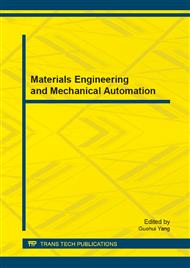p.443
p.450
p.458
p.466
p.472
p.476
p.480
p.489
p.494
Part Shape Information Acquisition Based on Stereoscopic Vision
Abstract:
A clamping robot serving for several NC machines can recognize the best fit in manny blank parts. Forthermore, the shape information acquisition and pose measurment can be achieved by its computer vision system. The key question is that the clamping robot automatively choices the best fit part by statistical result of geometric dimension of all parts. The best fit part is the one that its length and its diameter are mostly proximate to the processing requirement. This choice method can save staff, reduce working allowance, and lessen finished cost. According to the shape information and position information, the robot can confirm the grab order, grab angle and finger joint distance. Firstly, the part image is smoothing by noise reduction technology, secondly, the feature points are extracted. The feature points present the information of the location of the mass center, the dip angle and diameter. Finally, the clamping robot can grab the most fit bar part by means of rotational motion, rectilinear motion, and finger open-close movement when the shape information and location information of the bar part have been confirmed.
Info:
Periodical:
Pages:
472-475
Citation:
Online since:
October 2013
Authors:
Price:
Сopyright:
© 2014 Trans Tech Publications Ltd. All Rights Reserved
Share:
Citation:


